Now that, according to Marc Andreessen, “Software is eating the world,” more and more companies look for Agile as the rescue to address the challenge of digitalization. This makes complete sense because if every company becomes a software company (also if it doesn’t know it yet) and if Agile is the approach for software development, why not take Agile to the company level?
What's at the Core of Agility?
However, some people (including some consultants) treat the concept of Agile as the ultimate hammer that can be used to nail anything – no matter if it’s really a nail or not. Thus, you can see advice as using a product backlog at the board level, substituting management meetings with daily stand-ups, and visualize all work using a Kanban board. All these techniques might be helpful, but be aware that they will not make any company Agile.
Inspect-and-Adapt on the Path to Continuous Learning
What is needed instead is looking at the core of agility, that is, inspect-and-adapt (through regular feedback and continuous learning):  Putting to practice the tools and ceremonies associated with the framework won't make you Agile without a change in your attitude.
Putting to practice the tools and ceremonies associated with the framework won't make you Agile without a change in your attitude.
For example, you can use inspect-and-adapt to make performance evaluations or the processes around salary increases more agile. And at the core of doing so is, considering what makes sense (the plan), executing, inspecting, and then adapting it.
A colleague of mine, who is the director of a company, reported that they used this approach to make the decisions on salaries more agile. However, it wasn’t the management starting this process (note, any change can start anywhere); instead, it was a small group of people who decided on a series of experiments.
At first, all members of the small group decided to make all their salaries transparent amongst themselves. This created some discussion both within this group but also in the whole company. Then that group even went a step further, and they made their salaries transparent to all their colleagues. More and more colleagues followed their role models. The discussion that followed triggered the creation of a new process that they also changed a few times and is currently settled like this:
- There is an elected person taking part in all salary discussions (salary representative)
- Before salary discussions start, management calculates how much money is available for increases (increase budget)
- Management defines a set of company interests that are so important that they should be supported by every employee (e.g. the employee helps to achieve both customer and team satisfaction)
- In the salary discussion meeting the following people take part:
- The person under discussion
- Two people the person under discussion invites (typically peers)
- The elected salary representative
- The director of the branch the person under discussion works
- The salary discussion follows a defined process:
- Agreement on the goal of the meeting
- Open discussion which completes the picture of the person under discussion by hearing from all perspectives on the person’s growth, achievements, or under-achievements.
- Everyone decides by playing a card how the person under discussion is doing in terms of the defined company interests. The cards reflect if there are examples that the person has shown the support of this company interest, e.g. if the person has tried to support it, has supported it sometimes, is supporting it many times, is even inspiring others to support that goal, or if there are no such examples. The group doesn’t try to reach a consensus on this, it only uses the company interests and the cards for heaving an in-depth exchange and completing the joint understanding of the person’s contributions.
- Knowing the person’s actual salary, everyone writes secretly on a sticky note the suggested new salary. After everyone has shown their suggestion and provided some rationale, the group agrees on a suggested new salary for the person.
- Only after all salary discussions (with all employees) have been carried out, the management team adds up all the deltas of the suggested salary increases and verifies if this is within the planned budget. If the sum of all deltas overruns the budget, all deltas are proportionally deducted.
This is a very specific example of applying company-wide agility. Note, you didn’t hear about the usage of any of the Agile tools mentioned above, but still it is about applying agility. And actually, it is more about agility then using a stand-up meeting for the meetings of the board of directors. Why is it so? Because it takes the values from the Agile manifesto, translates those from the software / IT context to the company context, and uses an inspect-and-adapt approach to come to a solution.
Translating the Agile Values
So next to the inspect-and-adapt approach, in order to get started, you need a translation of the Agile values. 
We have done this translation for you (see #agilebossanova*). And without going into too many details (maybe this could be a different blog), here is how those values translate from the context of software to the context of a company:
- Individuals and interactions over processes and tools→ Self-organization
- Working software over comprehensive documentation→ Transparency
- Customer collaboration over contract negotiation→ Constant customer focus
- Responding to change over following a plan→ Continuous learning
If you take those values seriously at the company level and use an inspect-and-adapt approach you have a good chance to not only survive but also to thrive on the disruption(s) digitalization provides for your company.

Jutta Eckstein
Guest Author
Jutta works as an independent coach, consultant, trainer, author, and speaker. She has helped many teams and organizations worldwide to make an agile transition. She has published her experiences in her books, the most recent one is Company-wide Agility with Beyond Budgeting, Open Space & Sociocracy.



